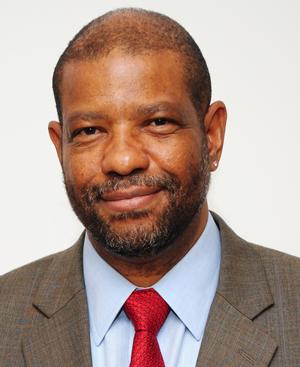March 7, 2016

Answering telephones for all the reporters in the Washington Bureau at National Public Radio propelled new tenure-track Journalism Department Professor Benjamin Davis from a receptionist to a successful journalist with a distinguished career in reporting and educating.
“We were always short staffed, so they would send me to news conferences to fill in the gaps. Whether they be in the U.S. Department of State, the Pentagon, the White House…All of these places. I got to go,” said Davis, who joined the Journalism faculty last August. He is one of two new assistant professors. (See below, Spotlight on New Professor.)
NPR would get someone to cover his job answering the phones, quickly show him how to use a microphone, and send him out into the field to cover a news conferences when they were low on reporters, he recalled.
After learning how to report firsthand, Davis cultivated a lengthy resume, which includes NPR, CBS, ABC News, MSNBC.com, the Huffington Post and now, CSUN.
Davis has been on a long road to success since his days at NPR. After receiving his Bachelor’s degree at Whittier College in California, he went on to graduate from the journalism graduate school at Colombia University. He later studied at the University of Copenhagen in Denmark.
Although Davis has a history in reporting, teaching has been his true passion for a while.
“I always taught. For the past 15 years, I’ve taught. I love teaching. It’s the best. It really is.”
It was in a classroom that Davis realized the standard news format of the inverted pyramid didn’t apply to the new media world. When he came to this realization, he replaced the 100-year-old concept with a new model, called the Digital Media Pyramid.
His model shows the non-professional reporter what the rules of reporting are in the digital world, he said.
The Digital Media Pyramid, also the title of Davis’ 2013 e-book, is intended as a resource for bloggers, students, news reporters, and others who write online, he said. The book demonstrates how to responsibly use videos, links, photographs and advertisements.
Now, Davis teaches this model to students taking the broadcast courses and radio practicum at CSUN. In class, he emphasizes the importance of ethics in digital journalism. Although he acknowledges traditional reporting methods, he focuses on merging modern techniques with past ones, he said.
“I took the merge of old television reporting and radio, and put it all together to this digital format. It’s all about creating an experience for the reader that builds trust between the journalist and their reader. The more they trust you, the more they are going to come back,” he said.
In addition to teaching, Davis has been writing a new book as part of his research and scholarly activities. In it, he dissects the messages in his exploration of the origins of the words "black" and "white."
“We are supposed to tell the truth as journalists, but the truth is there really aren’t 'white' and 'black' people,” Davis said. “A lot of people don't want to face the reality of what it means. Plenty of people cling to these terms.”
- Adrienne Ryser
